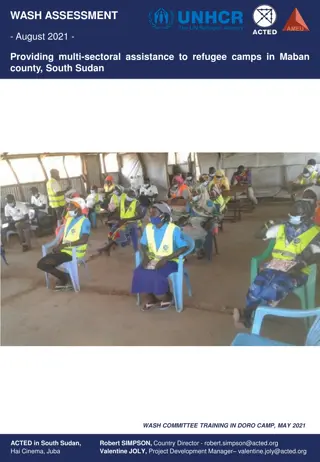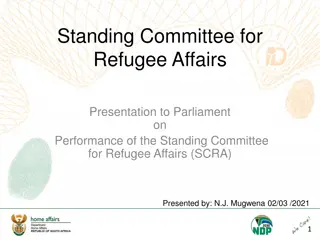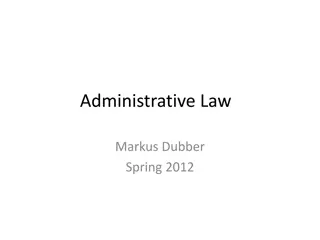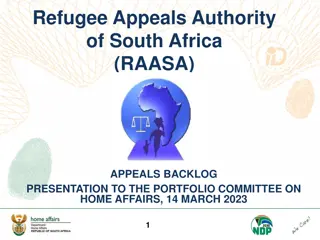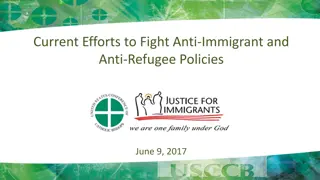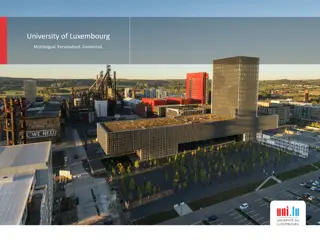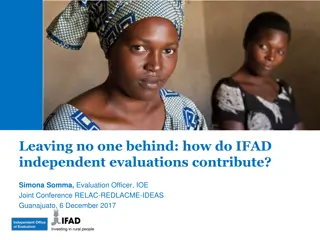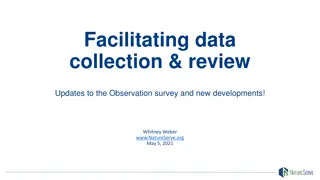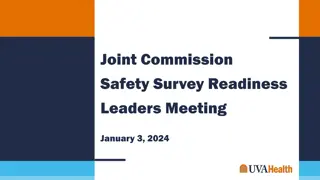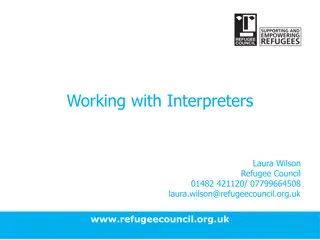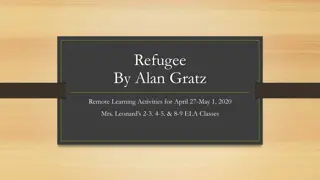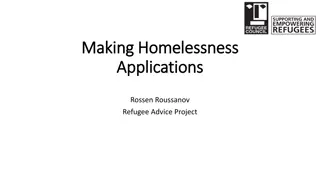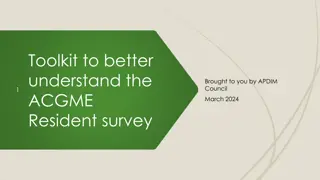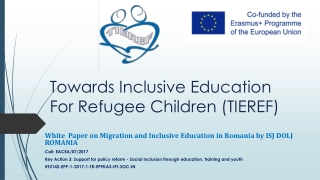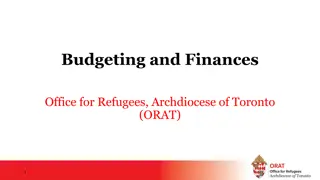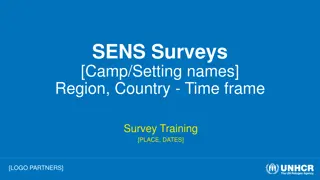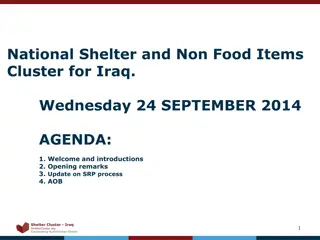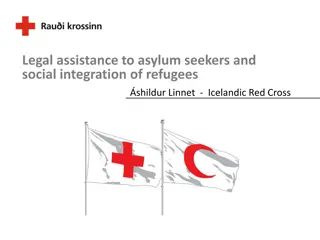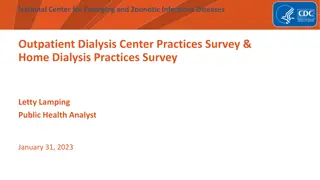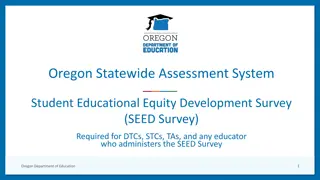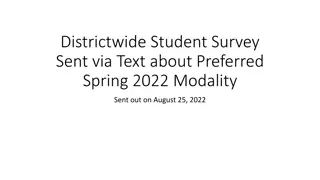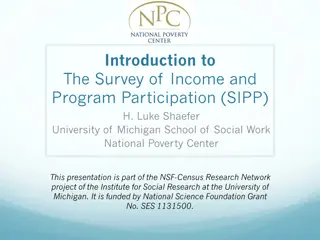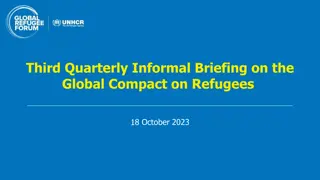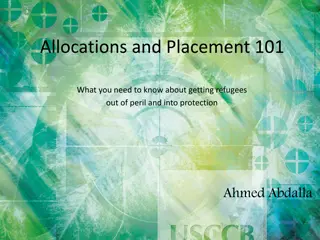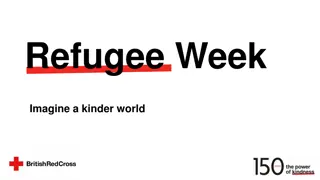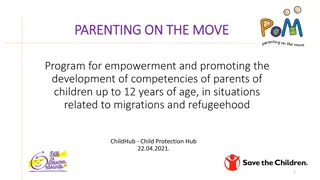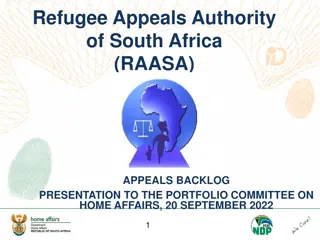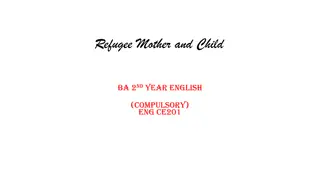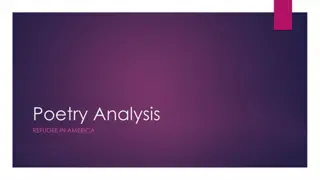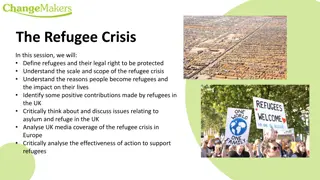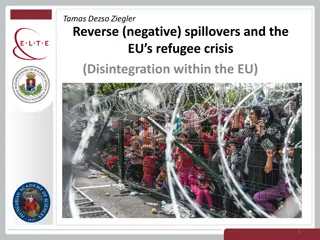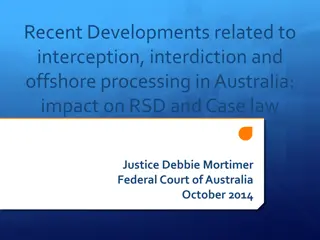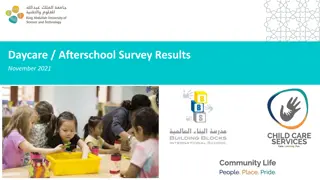Improving Refugee Targeting: Utilizing Survey Data for Better Assistance Programs
The World Bank and UNHCR collaborate to enhance the effectiveness of assisting Syrian refugees by leveraging survey data to optimize targeting strategies for cash assistance programs. By combining registry and survey information, the study aims to identify the best welfare and poverty indicators, ultimately aiming to improve the overall refugee assistance process.
Download Presentation

Please find below an Image/Link to download the presentation.
The content on the website is provided AS IS for your information and personal use only. It may not be sold, licensed, or shared on other websites without obtaining consent from the author. Download presentation by click this link. If you encounter any issues during the download, it is possible that the publisher has removed the file from their server.
E N D
Presentation Transcript
Using Survey Data to Improve Registry Data The Case of Syrian Refugees Paolo Verme World Bank
Motivation UNHCR keeps records of all refugees registered with the proGres database UNHCR collects a rich set of additional information via home visits surveys This information is little exploited for analysis UNHCR needs to target refugees with its cash assistance program due to funding shortages How good is the UNHCR targeting capacity? Can UNHCR improve its targeting capacity by making better use of available information and reduce the cost of surveys?
Background A WB-UNHCR partnership: WB analytical expertise on poverty and welfare and UNHCR expertise on refugees Pilot study in March 2014 Two countries (Jordan and Lebanon) 6 Data sets (3 Jordan and 3 Lebanon): UNHCR registry for Jordan and Lebanon (PG: 650,000 records Jordan; 1.2 m records Lebanon); UNHCR and WFP home visits (45,000 cases in Jordan, 2 rounds; 30,000 cases Lebanon, 1 round) UNHCR and WFP survey (1,700 cases Lebanon, 1 round) Focus on refugees living outside camps How Poor Are Refugees? A Welfare Assessment of Syrian Refugees Living in Jordan and Lebanon (16 December, 2015)
Basic Idea 1. Construct welfare aggregates 2. Construct a welfare and poverty model with PG+HV data 3. Tests best proxies for welfare and poverty 4. Tests composite indexes for welfare 5. Derive the best welfare and poverty models (PG+HV data) 6. Find the best variables to add to the proGres data 7. Predict welfare and poverty using PG data 8. Use the new PG model for targeting assistance programs
1) Construct Welfare Aggregate 100% 90% 80% 44.7 70% 60% 81.8 83.9 50% 40% 39.2 30% 20% 2.1 0.0 10% 16.1 16.1 16.1 0% Income per capita Expenditure per capita Expenditure per capita net of UNHCR assistance Missing Zeroes Positive
1) Construct Welfare Aggregate .8 .6 .4 .2 0 0 2 4 x 6 8 Exp/cap with UNHCR cash Exp/cap without UNHCR cash Inc/cap with UNHCR cash
2) Construct Welfare Models PHASE I : ??= ? + ?1???+ ?2??+ ?3??+ ?? PHASE II : ??= ? + ????+ ?? ??= ????+ ??, PHASE III : ??= ? + ????+ ?2 ?+ ?? ??= ????+ ?2 ?+ ?? Where W=welfare measure (income, expenditure or poverty); HP=vector of case characteristics present in both the PG and HV databases; H=vector of case characteristics present in the HV data but not in the PG data; P=vector of case characteristics present in the PG data but not in the HV data; h=Subset of H significant in Phase I; i= normally distributed error term with zero means; i=household (case number in UNHCR data).
3) Test best proxies of Welfare Basic tabulations Univariate regressions on 185 variables Ranking by R2 Multivariate tests: Backward and forward regressions Manual tests of key explanatory variables Tests repeated for composite welfare indicators Maximizing R squared
3) Test best proxies of Welfare High Skills skills Low Skills White Collars occup Blue Collars Edu less than 8 years educat Edu 8 years of less Arab ethnic Non Arab Muslim religion Non Muslim 25/2/2014-1/10/2014 time 1/11/2013-24/2/2014 Female gender Male 0.0 10.0 20.0 30.0 40.0 50.0 60.0 70.0 80.0
3) Test best proxies of Welfare Variable csize_hv dem_p_child edu_p_attend pov_inc_unhcr Description Individuals in case (HV) Proportion of children Proportion of children in school UNHCR Monthly Financial Assistance Large Family &/or Family with Babies, Toddlers or Children Attending School Obs 15975 15975 15975 15787 W R2 lin 0.470121638 0.312118415 0.152996621 0.150577538 cash_large prot_bail_date pov_cop_aid cash_smother prot_aggr cash_elderly prot_moi_diff_apolice pov_inc_aggr prot_bail cash_decision pov_cop_host ref_elderly prot_know_school edu_p_notattend house_sanitary dem_pafemale 5000 708 15788 5000 3863 5000 187 15787 13212 15811 15788 1111 14949 15975 15602 15835 0.135079263 0.100568917 0.092286375 0.058084132 0.050228105 0.048847739 0.041721867 0.03765949 0.035152565 0.034241792 0.029711534 0.028308115 0.022848084 0.02232405 0.021637243 0.021228419 Humanitarian assistance Single Women Score for work and residence permit, MOI and bail out doc Elderly 60 and Above Not comfortable approaching a police station Total number of kinds of income BailedOutFromCamp Decision_for_cash_Assistance Living together with host family Elderly alone School Proportion of children not in school SanitaryFacilitiesStatus Female Principal Applicant
4) Test Composite Indexes of Welfare Variable Obs Mean Std. Dev. Min Max R2 % 15975 0.91518 0.278622 0 1 0.017427 1.742672 i_rent 15975 0.773083 0.418852 0 1 0.014387 1.438695 i_latrine 15975 0.476557 0.499466 0 1 0.013578 1.357762 i_good_liv~d 15975 0.86723 0.339337 0 1 0.007125 0.712506 i_housecon~n 15975 0.878685 0.326503 0 1 0.007003 0.700316 i_pipewater 15975 0.138717 0.345662 0 1 0.006762 0.676154 i_good_san~y 15975 0.28626 0.452026 0 1 0.006047 0.604679 i_good_ven~n 15975 0.746792 0.434863 0 1 0.005852 0.585157 i_waste 15975 0.797684 0.401739 0 1 0.005125 0.512468 i_water 15975 0.281189 0.449594 0 1 0.005017 0.501678 i_good_ele~y
4) Test Composite Indexes of Welfare Variable Obs Mean Std. Dev. Min Max R2 ind_house_crowd 15975 1.781887 1.364509 0 16 0.267 15975 2.551506 1.697571 0 58 0.022 ind_house_crowd1 ind_wash_water 15975 3.196244 1.168634 0 4 0.014 15975 0.16169 0.381374 0 7 0.011 ind_nfi ind_house_subjective 15975 1.736588 1.619757 0 6 0.009 15975 8.3682 3.006631 0 13 0.008 ind_house_assets 15975 2.448013 1.727429 0 5 0.007 ind_cope_index ind_wash_hygiene 15975 4.192363 1.150333 0 5 0.007 15975 1.665477 1.481963 0 8 0.006 ind_cope_wfp 15975 42.55236 16.63382 0 112 0.003 ind_food_wfp ind_house_quality 15975 1.685383 0.57311 0 2 0.003 ind_food_score 15975 22.13459 8.49884 0 56 0.002 15975 7.101659 1.576538 0 8 0.001 ind_food_variety
Only PG variables PG + house + wash All variables Variable importance 18.09% 5) Derive the optimal Welfare Model (PG+HV) Coef. -0.47 -0.83 -1.04 -1.19 -1.42 -1.45 -1.66 -2.36 -0.05 -0.06 -0.09 0.00 0.01 0.02 0.07 0.07 0.07 -0.13 -0.12 -0.10 0.06 0.11 0.13 0.25 -0.11 -0.03 -0.04 0.00 -0.33 -0.06 -0.32 -0.03 -0.10 -0.05 -0.17 0.07 0.05 t Coef. -0.47 -0.83 -1.04 -1.19 -1.40 -1.43 -1.62 -2.32 -0.06 -0.07 -0.08 0.03 0.02 0.01 0.06 0.06 0.04 -0.10 -0.10 -0.07 0.02 0.05 0.07 0.18 -0.01 -0.05 -0.02 -0.03 -0.02 -0.11 -0.04 -0.03 -0.13 0.04 -0.14 0.05 -0.01 t Coef. -0.47 -0.83 -1.05 -1.20 -1.41 -1.44 -1.63 -2.32 -0.06 -0.06 -0.07 0.03 0.01 0.01 0.06 0.06 0.05 -0.10 -0.10 -0.06 0.02 0.05 0.06 0.16 -0.03 -0.06 -0.04 -0.02 -0.02 -0.09 -0.05 -0.02 -0.13 0.06 -0.14 0.06 0.00 t Case size (Ref. Csize=1) 2 3 4 5 6 7 8 - 11 >=12 0 - 50% 50% - 75% >75% Low Skilled Skilled High Skilled Professional 35-54 years >=55 years Divorced or separated. Single Widowed 6-8 years 9-11 years 12-14 years At least university Al-hasakeh Aleppo Ar-raqqa Dar'a Hama Homs Idleb Rural Damascus Tartous As-sweida Deir-ez-zor Lattakia Quneitra -34.9 -48.5 -61.3 -67.6 -77.2 -68.4 -80.4 -36.6 -2.9 -4.2 -5.4 0.1 1.0 1.6 5.1 8.7 5.8 -5.5 -9.7 -7.0 7.1 10.1 10.6 14.9 -2.8 -2.2 -1.6 0.2 -19.3 -4.7 -11.8 -2.2 -0.9 -0.6 -4.3 1.2 1.1 -36.5 -50.0 -62.9 -68.9 -77.9 -68.8 -79.9 -37.3 -4.0 -4.9 -5.1 2.4 1.6 0.9 4.4 7.8 3.7 -4.3 -8.6 -5.3 2.2 5.0 5.8 10.9 -0.2 -3.2 -0.9 -2.2 -1.2 -8.5 -1.3 -1.9 -1.1 0.5 -3.6 1.0 -0.2 -35.8 -49.0 -61.9 -68.0 -76.4 -67.9 -78.8 -36.9 -3.7 -4.4 -4.4 2.2 1.1 0.7 4.4 8.0 4.3 -4.2 -8.2 -4.3 2.2 4.6 5.2 9.9 -0.7 -4.0 -1.6 -1.7 -1.4 -7.3 -1.7 -1.7 -1.1 0.8 -3.6 1.1 -0.1 Proportion of children <18 years (Ref. =0) 0.05% Employment of PA ( Ref. None) 0.07% Age of PA ( Ref: <=34 years) 0.15% Marital status of PA (Ref. Married or engaged) 0.20% Highest education of PA ( Ref. Below 6 years) 0.10% Origin (Ref. Damascus) 0.17%
Legal arrival Destination (Ref. Amman) 0.12 -0.12 0.06 -0.08 -0.08 -0.13 -0.14 -0.14 -0.16 -0.21 -0.40 -0.25 -0.01 -0.06 -0.07 -0.04 13.3 -4.6 1.0 -4.9 -8.7 -5.6 -6.3 -4.5 -7.2 -19.8 -9.5 -22.6 -0.6 -3.7 -6.2 -3.0 0.09 -0.14 0.04 -0.07 -0.08 -0.15 -0.15 -0.14 -0.12 -0.10 -0.45 -0.21 0.06 -0.05 -0.05 -0.02 0.10 0.04 0.05 0.59 0.10 0.02 0.11 0.04 9.9 -5.6 0.7 -4.2 -9.0 -6.5 -7.2 -4.7 -5.4 -9.3 -11.1 -20.0 4.1 -3.2 -5.1 -1.8 11.6 3.3 5.5 39.8 6.8 3.0 14.4 5.3 0.08 -0.16 0.02 -0.07 -0.09 -0.19 -0.15 -0.13 -0.11 -0.08 -0.48 -0.20 0.06 -0.04 -0.04 -0.02 0.11 0.04 0.05 0.60 0.12 0.02 0.09 0.04 -0.05 -0.15 -0.12 -0.04 0.06 -0.34 4.05 651.11 0.53 38694 9.0 -6.2 0.4 -4.3 -9.7 -8.0 -6.9 -4.2 -5.1 -7.0 -11.8 -18.6 3.6 -2.8 -4.0 -1.3 11.5 3.5 5.3 39.9 8.1 2.7 11.5 4.5 -5.9 -16.0 -17.5 -6.0 7.1 -31.7 142.5 0.16% 1.12% Ajloun Aqabah Balqa Irbid Jarash Karak Maan Madaba Mafraq Tafilah Zarqa Ruwaished - Hadallat Tal Shihab Nasib-official or unofficial. other or no data. Welfare Model (Cont.) Border crossing point (Ref. Airport) 0.19% house_kitchen_d house_electricity_d house_ventilation_d house for rent or owned concrete_house House area:sq m per capita (Ref. <10 sq meters) 0.39% 0.07% 0.07% 3.55% 0.16% 0.31% 10-15 sq meters >15 sq meters wash_piped (water through piped AND piped sewerage) nfi_1_dummy (Receiving NFIs) pov_cop_aid (Coping strategy=humanitarian assistance) pov_cop_host (Coping strategy=host family) pov_cop_comm (Coping strategy=host community) prot_cert_valid (Is certificate valid) pov_inc_unhcr (UNHCR financial assistance) 0.05% 0.08% 0.58% 0.70% 0.09% 0.13% 2.28% -0.35 4.88 721.20 0.48 42217 -34.4 212.5 -0.40 4.05 727.92 0.53 40541 -40.2 152.4 _cons F statistic Adjusted R-squared N
6) Select the Best Variables to Add to PG Data The poverty model predicts poverty correctly 90.1% of the times PG-HV predictors: Case size Rent Place of destination (country and region) Official entry and point of entry Place of origin (Damascus vs other regions) HV predictors (h) Principal applicant characteristics (age and marital status) Selected assets (latrine, piped water, kitchen) Education and former occupation are less important than expected
7) Predict Welfare using new PG model Wexp_unhcr_lncap Coef t Individuals in case (HV) -0.212*** -69.811 Proportion of children -0.611*** -25.245 Concrete House 0.195*** 8.017 Santitation average or above 0.109*** 7.244 Ventilation average or above 0.100*** 6.194 Free Housing -0.705*** -24.419 Proportion school-aged children 0.113*** 8.919 Proportion of children in school -0.207*** -15.267 Sharing costs with host family -0.095*** -6.628 Living together with host family 0.114*** 8.987 IsCertificateValid 0.124*** 9.190 _cons 4.715*** 162.779 Number of observations 14,150 R2 0.555 Adjusted/Pseudo R2 0.554
8) Use New PG Model to Target Assistance Income Expenditure Non poor Poor Total Non poor 8.5 37.2 45.6 Poor 4.6 49.8 54.4 Total 13.1 86.9 100.0
Conclusion World Bank and UNHCR have complementary skills and resources Existing UNHCR data can be used to improve targeting: Shift from income to expenditure Reduce leaking and costs Improve coverage and targeting The analysis highlighted areas to improve: Data collection (survey design, sampling, questionnaires) Data management (PG management system, survey administration) Data analysis (economists and social protection officers)


